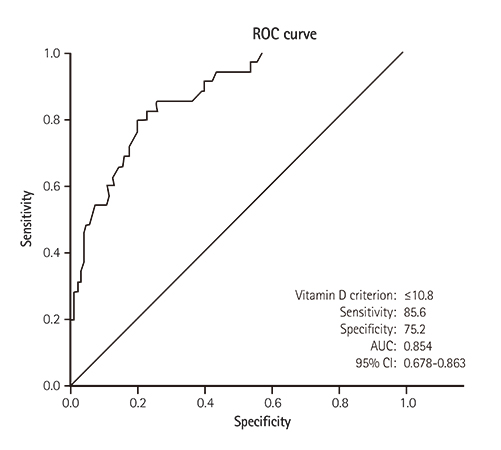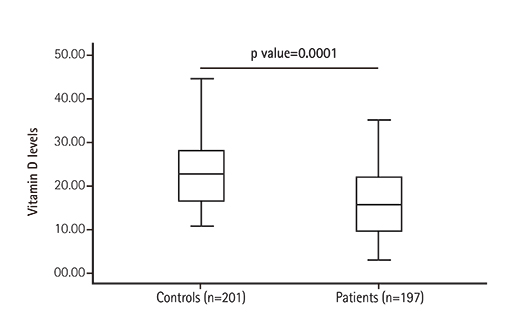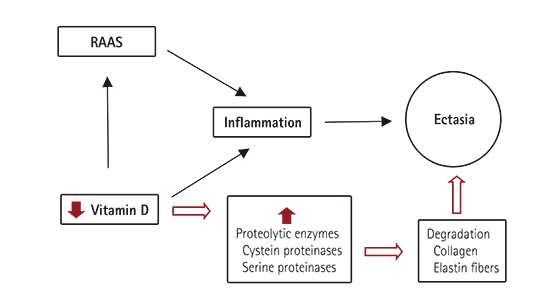Korean Circ J.
2017 Mar;47(2):231-237. 10.4070/kcj.2016.0198.
The Relationship between Vitamin D and Coronary Artery Ectasia in Subjects with a Normal C-Reactive Protein Level
- Affiliations
-
- 1Department of Cardiology, Antalya Education and Research Hospital, Antalya, Turkey. skucukseymen@gmail.com
- 2Department of Emergency Medicine, Antalya Education and Research Hospital, Antalya, Turkey.
- KMID: 2377464
- DOI: http://doi.org/10.4070/kcj.2016.0198
Abstract
- BACKGROUND AND OBJECTIVES
Vitamin D is generally known to be closely related to inflammation. The effects of vitamin D on coronary artery disease (CAD) are not fully explained. Nowadays, coronary artery ectasia (CAE) cases are common and are regarded as being a kind of CAD. We aimed to investigate, in a case-control study, the relationship between vitamin D and CAE without an associated inflammatory process.
SUBJECTS AND METHODS
This study population included 201 patients (CAE group, 121 males; mean age, 61.2±6.4 years) with isolated CAE; and 197 healthy individuals (control group, 119 males; mean age, 62.4±5.8 years), comprising the control group, who had normal coronary arteries. These participants concurrently underwent routine biochemical tests, tests for inflammatory markers, and tests for 25-OH vitamin D in whole-blood draws. These parameters were compared.
RESULTS
There are no statistical significance differences among the groups for basic clinical characteristics (p>0.05). Inflammatory markers were recorded and compared to exclude any inflammatory process. All of them were similar, and no statistical significance difference was found. The average parathyroid hormone (PTH) level of patients was higher than the average PTH level in controls (41.8±15.1 pg/mL vs. 19.1±5.81 pg/mL; p<0.001). Also, the average 25-OH vitamin D level of patients was lower than the average 25-OH vitamin D level of controls (14.5±6.3 ng/mL vs. 24.6±9.3 ng/mL; p<0.001). In receiver operating characteristic curve analysis, the observed cut-off value for vitamin D between the control group and patients was 10.8 and 85.6% sensitivity and 75.2% specificity (area under the curve: 0.854, 95% confidence interval: 0.678-0.863).
CONCLUSION
We found that there is an association between vitamin D and CAE in patients who had no inflammatory processes. Our study may provide evidence for the role of vitamin D as a non-inflammatory factor in the pathophysiology of CAE.
MeSH Terms
Figure
Reference
-
1. Giovannucci E. What is the optimal vitamin D level for health? Therapy. 2008; 5:655–658.2. Izadpanah M, Khalili H. Potential benefits of vitamin D supplementation in critically ill patients. Immunotherapy. 2013; 5:843–853.3. Zittermann A, Pilz S, Börgermann J, Gummert JF. Calcium supplementation and vitamin D: a trigger for adverse cardiovascular events? Future Cardiol. 2011; 7:725–727.4. Kota SK, Kota SK, Jammula S, et al. Renin-angiotensin system activity in vitamin D deficient, obese individuals with hypertension: an urban Indian study. Indian J Endocrinol Metab. 2011; 15:Suppl 4. S395–S401.5. Sata M, Fukuda D. Chronic inflammation and atherosclerosis: a critical role for renin angiotensin system that is activated by lifestyle-related diseases. Inflamm Regen. 2011; 31:245–255.6. Brady AR, Fowkes FG, Thompson SG, Powell JT. Aortic aneurysm diameter and risk of cardiovascular mortality. Arterioscler Thromb Vasc Biol. 2001; 21:1203–1207.7. Falsetti HL, Carrol RJ. Coronary artery aneurysm. A review of the literature with a report of 11 new cases. Chest. 1976; 69:630–636.8. Markis JE, Joffe CD, Cohn PF, et al. Clinical significance of coronary arterial ectasia. Am J Cardiol. 1976; 37:217–222.9. Demir M, Demir C, Keçeoğlu S. The relationship between vitamin D deficiency and coronary artery ectasia. Postepy Kardiol Interwencyjnej. 2014; 10:238–241.10. Koc F, Kalay N, Ardic I, et al. Antioxidant status and levels of antioxidant vitamins in coronary artery ectasia. Coron Artery Dis. 2011; 22:306–310.11. Lin CT, Chen CW, Lin TK, et al. Coronary artery ectasia. Tzu Chi Med J. 2008; 20:270–274.12. Dogan A, Tuzun N, Turker Y, Akcay S, Kaya S, Ozaydin M. Matrix metalloproteinases and inflammatory markers in coronary artery ectasia: their relationship to severity of coronary artery ectasia. Coron Artery Dis. 2008; 19:559–563.13. Finkelstein A, Michowitz Y, Abashidze A, Miller H, Keren G, George J. Temporal association between circulating proteolytic, inflammatory and neurohormonal markers in patients with coronary ectasia. Atherosclerosis. 2005; 179:353–359.14. Kocaman SA, Taçoy G, Sahinarslan A, Cengel A. Relationship between total and differential leukocyte counts and isolated coronary artery ectasia. Coron Artery Dis. 2008; 19:307–310.15. Krüger D, Stierle U, Herrmann G, Simon R, Sheikhzadeh A. Exercise-induced myocardial ischemia in isolated coronary artery ectasias and aneurysms (“dilated coronopathy”). J Am Coll Cardiol. 1999; 34:1461–1470.16. Hartnell GG, Parnell BM, Pridie RB. Coronary artery ectasia. Its prevalence and clinical significance in 4993 patients. Br Heart J. 1985; 54:392–395.17. Yalcin AA, Topuz M, Akturk IF, et al. Is there a correlation between coronary artery ectasia and neutrophil-lymphocyte ratio? Clin Appl Thromb Hemost. 2015; 21:229–234.18. Markis JE, Joffe CD, Cohn PF, Feen DJ, Herman MV, Gorlin R. Clinical significance of coronary arterial ectasia. Am J Cardiol. 1976; 37:217–222.19. Isik T, Kurt M, Ayhan E, et al. Relation of red cell distribution width with presence and severity of coronary artery ectasia. Clin Appl Thromb Hemost. 2012; 18:441–447.20. Guo YL, Luo SH, Tang Y, Li JJ. Association of red cell distribution width with the presence of coronary artery ectasia. Clin Lab. 2014; 60:199–205.21. Bilik MZ, Kaplan İ, Yıldız A, et al. Apelin levels in isolated coronary artery ectasia. Korean Circ J. 2015; 45:386–390.22. Turhan H, Erbay AR, Yasar AS, et al. Plasma soluble adhesion molecules; intercellular adhesion molecule-1, vascular cell adhesion molecule-1 and E-selectin levels in patients with isolated coronary artery ectasia. Coron Artery Dis. 2005; 16:45–50.23. Koc F, Ardic I, Erdem S, et al. Relationship between L arginine/asymmetric dimethylarginine, homocysteine, folic acid, vitamin B levels, and coronary artery ectasia. Coron Artery Dis. 2010; 21:445–449.24. Yasar AS, Erbay AR, Ayaz S, et al. Increased platelet activity in patients with isolated coronary artery ectasia. Coron Artery Dis. 2007; 18:451–454.25. Ke CY, Yang FL, Wu WT, et al. Vitamin D3 reduces tissue damage and oxidative stress caused by exhaustive exercise. Int J Med Sci. 2016; 13:147–153.26. Michos ED. Vitamin D deficiency and the risk of incident Type 2 diabetes. Future Cardiol. 2009; 5:15–18.27. Tohari AM, Zhou X, Shu X. Protection against oxidative stress by vitamin D in cone cells. Cell Biochem Funct. 2016; 34:82–94.28. Holick MF, Schnoes HK, DeLuca HF, Suda T, Cousins RJ. Isolation and identification of 1,25-dihydroxycholecalciferol. A metabolite of vitamin D active in intestine. Biochemistry. 1971; 10:2799–2804.29. Koli K, Keski-Oja J. 1alpha, 25-dihydroxyvitamin D3 and its analogues down-regulate cell invasion-associated proteases in cultured malignant cells. Cell Growth Differ. 2000; 11:221–229.30. Liu J, Sukhova GK, Yang JT, et al. Cathepsin L expression and regulation in human abdominal aortic aneurysm, atherosclerosis, and vascular cells. Atherosclerosis. 2006; 184:302–311.
- Full Text Links
- Actions
-
Cited
- CITED
-
- Close
- Share
- Similar articles
-
- Apelin Levels In Isolated Coronary Artery Ectasia
- Plasma Homocysteine, Folate and Vitamin B12 Concentrations in Coronary Artery Disease
- Coronary Artery Disease and Retinol Binding Protein 4
- Severity of Coronary Atherosclerosis; Influence of Metabolic Syndrome Risk Factor Clustering and hs-CRP
- Two Different Successful Angioplasty Methods in Patients with Stenotic Coronary Artery Ectasia




